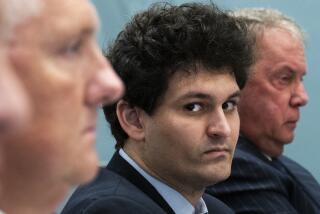Review: Nate Silver’s insightful ‘The Signal and the Noise’
The Signal and the Noise
Why So Many Predictions Fail — but Some Don’t
Nate Silver
Penguin Press: 534 pp, $27.95
Political consulting and punditry are worlds where merit is all too often a minor concern at best — coming in behind convictions, connections and just plain swagger, among a long list of other things.
Sometimes it seems as if the whole thing might be working on a tenure system: How else can anyone explain why Dick Morris is still paid to make bold predictions on national television almost seven years after the release of his book about the 2008 election, “Condi vs. Hillary: The Next Great Presidential Race,” or why John Kerry picked Democratic operative Bob Shrum as one of his top advisers for his 2004 run after Shrum had already racked up an 0-7 record in presidential campaigns?
And yet during the 2008 elections, it took mere months for Nate Silver to become one of the political world’s most respected experts, the guy anyone who wanted to be taken seriously had to cite. With good reason: Unlike so many of the people who make their living predicting elections, Nate Silver can do math.
Silver, who got his start working with baseball statistics before eventually moving on to politics and founding his website FiveThirtyEight.com (now part of the New York Times), acknowledges as much in his new book, “The Signal and the Noise: Why So Many Predictions Fail — but Some Don’t.”
“I’ve been fortunate enough to take advantage of fields where the water level was set pretty low, and getting the basics right counted for a lot,” Silver writes. “Baseball, in the pre-’Moneyball’ era, used to be one of these.... In politics, I’d expect that I’d have a small edge at best if there were a dozen clones of FiveThirtyEight. But often I’m effectively ‘competing’ against political pundits, like those on ‘The McLaughlin Group,’ who aren’t really even trying to make accurate predictions.”
That may be a little too modest of an assertion on Silver’s part — he is extremely good at what he does — but it’s a point that goes to the central thread underlying his book: There is still a wide gap between what we think we know, what we think we can predict (or, as in Silver’s “McLaughlin Group” example, what we’re basically just pretending to predict) and what we can actually do. But we can get better.
The people who follow Silver for his political work — or for his insights on baseball — may be disappointed to see that there’s not all that much of either in “The Signal and the Noise.” But a book about politics is only about politics. Silver’s aiming for something bigger here: He wants to change how we think about predictions in every aspect of our lives. (In one memorable section, he demonstrates how an algebraic equation used to determine probability can be employed to determine the likelihood that a woman’s partner is cheating on her if she comes home to find another woman’s underwear in his drawer.)
The book is essentially a series of essays about forecasts and predictions in all sorts of different areas — everything from the economy to earthquakes, poker, weather and global warming. One gets the feeling, reading it, that Silver wants his work to be something like Malcolm Gladwell’s: The hot new read for people in business and finance who want to improve their forecasting abilities.
If that does happen, we’ll probably all be better off. Silver has insights even for those of us who lack his math skills and knowledge. He wants us to “stop and smell the data — slow down, and consider the imperfections in your thinking.”
He makes a convincing case as to why we should do so and how things such as the financial crisis might have been alleviated or even avoided if enough people had considered their assumptions more carefully and searched for the ways in which they might be wrong.
In that sense, “The Signal and the Noise” could be an important book, even if it is not actually a great one. Numbers in one form or another may be the project of Silver’s life, but at times the book reads less like a passion project than a commercial venture. It never truly finds itself, instead veering from memoir to self-help guide to textbook to polemic and back again.
To really come together, it needed a better sense of purpose — and perhaps a stronger editor. In some places, the writing just plods along, thanks to Silver’s tendency toward overexplanation. Does any book really need 45 footnotes in its first 14 pages?
“The Signal and the Noise” never quite reaches its potential or its author’s. But there are moments when it sparkles — when Silver’s intelligence, his knack for explaining complicated concepts to the layperson, come through, and we see again why he and his blog have had so much influence on the coverage of this election and 2008’s.
Silver himself might warn us against making too confident a prediction about the effect of his book, but we can at least hope for a repeat performance.
Koppelman is on the staff of the New Yorker.
More to Read
The biggest entertainment stories
Get our big stories about Hollywood, film, television, music, arts, culture and more right in your inbox as soon as they publish.
You may occasionally receive promotional content from the Los Angeles Times.










